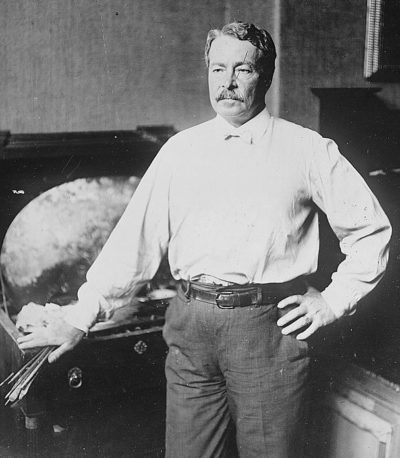Childe Hassam (Childe Hassam)

Impressionist Painter. Born in his family home in a suburb of Boston in 1859. His father Frederick was a cutlery merchant and descended from a long line of New Englanders, while his mother Rosa was a native of Maine. Childe Hassam demonstrated an interest in art early in his life. He had his first lessons in drawing and watercolor while attending the Mather public school. A disastrous fire in November 1872 wiped out much of Boston’s commercial district including his father’s business. Childe dropped out of high school to help his family. After his father realized he was terrible with numbers he allowed him to pursue an art career, and Childe found employment with George Johnson, a wood engraver. He quickly proved an adept draftsman and he produced designs for commercial engravings, such as images for letterheads and newspapers. Around 1879, he began creating his earliest oil paintings but his preferred medium was watercolors, mostly outdoor studies. After establishing his reputation in Boston between 1882 and 1886, Childe studied from 1886 to 1889 in Paris. There he was unusual among his American contemporaries in his attraction to French Impressionism, which was just beginning to find favor with American collectors. He returned to the United States late in 1889 and took up lifelong residence in New York. His signature images include views of Boston, Paris, and New York, three urban centers whose places and pleasures he captured with affection and originality. Examples include Winter in Union Square and Spring Morning in the Heart of the City, both of which record lively sections of New York during the first decade of Childe’s activity there. In February 1884, Childe married Kathleen Maude Doane. Throughout their life together, she ran the household, arranged travel, and attended to other domestic tasks, yet little else is known about their private life. Although Childe Hassam had shown steady improvement in his oil painting, before letting go of illustration Childe Hassam decided to return to Paris with his wife. His first Parisian works were street scenes, employing a mostly brown palette, and he sent these works back to Boston for sale, which combined with older watercolors provided the couple with sufficient income to sustain their stay abroad. In the autumn of 1887, Childe painted two versions of Grand Prix Day, employing a breakthrough change of palette. Suddenly, he was laying softer, more diffuse colors to canvas, similar to the French Impressionists, creating scenes full of light, done with freer brush strokes. Through the 1890’s, his technique veered increasingly toward Impressionism in both oil and watercolor, even as the movement itself was giving way to Post-Impressionism and Fauvism. During his European stay, he continued to favor street and horse scenes, avoiding some of the other favorite depictions of the Impressionists, such as opera, cabaret, theater, and boating. He also painted garden and “flower girl” scenes, some featuring his wife, including Geraniums (1888) which he presented at the Salon exhibition that year. He managed to exhibit at all three Salon shows during his Paris stay. After returning to the United States and moving to New York in 1889, he resumed his studio illustration and in good weather produced landscapes out of doors. He found a studio apartment at Fifth Avenue and Seventeenth Street, a view he painted in one of his first New York oils, Fifth Avenue in Winter. The fashionable street was traveled at that time by horse-drawn carriages and trolleys. It was one of his favorite paintings and he exhibited it several times. For his Washington Arch in Spring in 1890, he instead demonstrated a bright pastel palette suffused with white similar to what Monet might have employed. While Childe was unusual among the American Impressionists for his frequent depictions of burgeoning cities, he spent long periods in the countryside. There he found respite from urban pressures and inspiration for numerous important works of art. Childe’s many portrayals of the old fashioned gardens, rocky coast, and radiant sunlight of the Isles of Shoals, Maine, are among his most cherished works. Among them is the 1901 view Coast Scene, Isles of Shoals, the first canvas by the artist to enter the collection of the Metropolitan Museum. His images of Newport, Portsmouth, Old Lyme, Gloucester, and other New England locales also exemplify the late nineteenth-century appreciation of the picturesque region redolent of early American settlement and colonial growth. In 1919, Childe and his wife purchased a colonial-period house in East Hampton, on the south fork of Long Island, New York, and made it their summer headquarters. Childe Hassam created more than 2,000 oils, watercolors, pastels, and illustrations, and after 1912 more than 400 etchings and other prints. With these works he achieved critical acclaim and commercial success, riding the great wave of enthusiasm for American Impressionism to fame and fortune. Childe Hassam died in East Hampton, New York at the age of 75. (bio by: Shock) Family links: Spouse: Kathleen Maud Doane Hassam (1862 – 1946)* *Calculated relationship
Born
- October, 17, 1859
- USA
- Boston, Massachusetts
Died
- August, 08, 1935
- USA
- East Hampton, New York
Cemetery
- Cedar Lawn Cemetery
- East Hampton, New York
- USA



